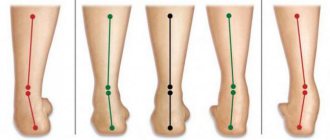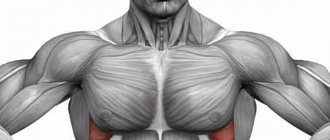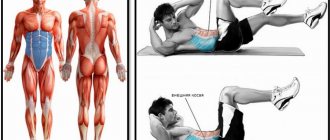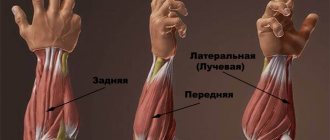Fat or weightlifter?
You can often find a common example in the comparison of fat and muscle: a well-fed person can weigh 100 kg and not look very beautiful, and a bodybuilder who also weighs 100 kg, but has a low percentage of fat, nevertheless looks quite aesthetically pleasing. Same weight, but different shape. In the first case, the person will seem much larger in size than the second, but meanwhile they have the same weight, so what is the mystery?
Having understood the question “Which is heavier: muscles or fat in a person,” everyone can clearly understand what actions they need to take depending on their goal of building a figure. After all, only having certain knowledge in a certain matter can you competently approach solving a problem.
Both sides of the equation can change
Perhaps most overlooked in most people's understanding of how fat burning and weight loss works is the fact that both sides of the energy balance equation can change and this alone results in weight being lost in a different way than expected. calculations. Let me emphasize again that here we are assuming that the person is strictly following a diet and following a training program. And, just for the purposes of the current discussion, we are completely ignoring fluid retention.
Everyone wants energy balance to work this way: a caloric deficit is created (compared to the calculated maintenance level) and weight is gradually, linearly and evenly reduced at a given pace. From this misunderstanding comes such stupid ideas as “if you cut your diet by 100 kcal per day, you will lose this much weight.”
But the system adapts to changes in energy (food), activity and weight. Here's a simple example: let's take the thermic effect of food (TEF), calories spent on digestion, breakdown, absorption, etc. food. It is estimated that TEP makes up 10% of your total caloric intake, and if you cut your calorie intake by 500 per day, your calorie expenditure will also be reduced by 50 kcal. So the estimated deficit of 500 kcal has already been reduced to 450 kcal and the estimated figure of half a kilo of fat per week cannot be achieved.
In other words, if the weight loss/fat loss math were as simple as “reduce your food intake by 500 kcal per day to lose a pound of weight per week, and keep going until you win,” humans would already be extinct. And we know that everything happens completely differently.
Weight decreases at a certain rate, the decline slows down, and we hit a plateau - this happens even if food intake and physical activity remain unchanged. And the only way to resume weight loss is to create a new deficit by cutting back on food or increasing activity.
And all because the expenditure part of the energy balance equation is dynamic and all its components are subject to change. They change at different rates and in different ranges, depending on many factors. And these changes concern not only what is happening in the short term, but also long-term processes
In the real world, to predict the rate of change in weight or body fat, all of these compensatory mechanisms need to be taken into account.
Most make incorrect and unfounded assumptions about how quickly weight/fat should be lost and how energy balance works, and then when things don't go as they expected, they conclude that the concept of balance itself is wrong. But what is rather wrong is the idea of what the “3500 kcal rule” is, the effect of “water” weight, and changes in energy expenditure. The equation is quite reliable, it's just a little more complicated than many people think.
13. Schoeller DA et. al.Effect of dietary adherence on the body weight plateau: a mathematical model incorporating intermittent compliance with energy intake prescription.Am J Clin Nutr. 2014)100(3):787-95. 14. Thomas DM et. al. Can a weight loss of one pound a week be achieved with a 3500-kcal deficit? Commentary on a commonly accepted rule.Int J Obes (Lond). 2013 Dec;37(12):1611-3. 15. Heymsfield SB et. al. Energy content of weight loss: kinetic features during voluntary caloric restriction.Metabolism. 2012 Jul;61(7):937-43. 16. Dhurandhar EJ et. al. Predicting adult weight change in the real world: a systematic review and meta-analysis accounting for compensatory changes in energy intake or expenditure. Int J Obes (Lond). 2014 Oct 17. Epub before print
Original text:
Translation: shantramora.lj.ru
Thursday, 05/26/2016
Fat or muscle - which is heavier?
Having understood this topic, you can clearly understand why such dramatic differences in weight and appearance arise. When considering the question “is muscle or fat heavier?” from the point of view of cellular structure, the clear answer is that muscles are heavier, since their cells have a higher density compared to fat cells.
Muscle cells contain protein and water, while fat cells contain only fat, or lipids. You don’t need to have any special knowledge of body structure to understand that protein and water, aka muscles, will be much denser in composition than fat.
Functions of fat deposits
Fat is not a useless phenomenon; its critical level poses a threat to health, so you need to take a responsible approach to the process of losing weight. Layers of fat protect internal organs and create an additional source of heat in cold weather, which explains the decrease in metabolism in winter as the body tries to conserve fat reserves.
Having learned the answer to the question “fat or muscle - which is heavier”, many try in every way to get rid of fat, which exceeds muscle tissue in volume, but it is worth understanding that there is a limit beyond which it is not advisable to go.
The lowest threshold for a woman’s fat level is 12%, after which problems with both appearance and feminine appearance may begin. Men can feel great with 5% body fat.
However, a high percentage of fat is harmful to the body, since the likelihood of developing diabetes increases, energy decreases, metabolism slows down, and lethargy sets in.
How many calories are in 100 grams of human fat?
The goal of most people who actively count calories, exercise, and limit their diet is to eliminate excess fat. This same fat in our body also has its own calorie content. That is, this is the number of calories that need to be spent to burn a certain amount of fat. Let's consider what the calorie content of human fat is and what it consists of.
The answer to the question of how many calories are in human fat is 7716 kcal per kilogram. If we convert this value into pounds, we get approximately 3500 kcal per pound of subcutaneous fat.
One gram of pure fat contains 9 kilocalories. But why then is the number of calories in human fat different? The fact is that it is not fat in its pure form. It contains small amounts of water, connective tissue and other ballast compounds. These impurities are not taken into account when calculating fat in foods, but when calculating calories in a person’s subcutaneous fat, they need to be taken into account.
It follows that a gram of subcutaneous fat contains 7 kcal, and not the usual 9.
Knowing how many calories are in 1 kg of human fat, you can calculate how many calories you need to burn and consume to lose as much weight as you want. To lose weight, you need to create a calorie deficit, that is, spend more energy than you consume through food. Just create a difference of 500 kcal, and in two weeks you can lose a kilogram of pure fat.
If you create a calorie deficit of 1000 kcal daily, you can reduce the period of losing a kilogram of fat to one week. This is the speed that is still considered safe, but faster weight loss is fraught with negative consequences.
Please note that the express diets that are loved by many, through which you can lose a couple of kilograms in just 2-3 days, remove fluid from the body, which quickly returns when a person adheres to his usual diet again. Fat disappears later, and to get rid of it you need to regularly adhere to proper and moderate nutrition and exercise.
Fat reserves in the body have completely natural and necessary functions: they are responsible for protecting internal organs and supporting the body if you have to starve. It helps to recover from illness and enables women to bear and feed a child.
However, if fat is allowed to exist uncontrollably, in quantities that exceed the norm, it will begin to influence a number of processes occurring in the body. Abdominal fat affects and disrupts hormonal levels. With a high fat content, internal organs work hard. The body requires more and more calories, accordingly, the person overeats and gains even more weight. Excess weight puts stress on joints, blood vessels, limbs, and increases the risk of a huge list of diseases.
Therefore, it is important to keep your fat level normal and get rid of excess deposits. At the same time, it is important to know not only how many calories are in one kilogram of human fat, but also how to burn it correctly, since with a sharp and incorrect weight loss, it is not fat that will be lost first, but fluid and muscle mass, and the consequences can be very dangerous.
If you lose weight very quickly, you will lose more muscle mass than fat . As a result, muscle tissue that is capable of burning fat will disappear, and metabolic processes will slow down. Fats do not consume as many calories as muscles, which are destroyed under the influence of rapid weight loss. At the same time, the overall appearance of the body deteriorates, as the skin sags. When the diet comes to an end, the body first of all restores lost fat reserves, and only then begins to restore muscles, but still not to the same extent as before. As a result, weight becomes less, but not due to fats - there are more of them in the body, even if the weight is the same.
To maintain your weight at the same level, you need to consume significantly fewer calories, since fat uses nine times less energy than muscle mass. That is, you will have to go on an even stricter diet. And these are new negative consequences. The body will not cope with the restrictions, and will try to do everything to ensure that the fat in the body remains and increases, because it is a reserve in case of just such emergency situations. Metabolism will slow down significantly and, thus, you will only worsen both your figure and your health, although you want completely opposite results.
There is an opinion that the number of fat cells in the body is determined by a hereditary factor, such as eye or hair color. However, there is other information that refutes this opinion, and it lies in the fact that the number of fat cells in a child is determined by how the mother ate. It also became known that in obesity, fat cells can divide on their own, and then only surgical intervention can help overcome them.
Fat in the body is divided into several types: brown, subcutaneous and internal . The brown type of fat is needed so that the body can maintain the correct temperature. There is enough such fat in the body of infants - it protects them from hypothermia. Subcutaneous fat, as its name implies, is located directly under the skin and is the familiar cellulite. This is exactly the type of fat that we constantly struggle with. As for internal or visceral fat, it is deposited on the surface of human organs and inside them. Fat can grow into muscle tissue and even penetrate into the heart.
Together with the blood, excess fat circulates through the vessels, clogs them, and is deposited on the wall. It becomes difficult for blood to penetrate the body's cells, blood pressure rises, and possible malaise. Cholesterol plaques cause stroke and heart attack. Therefore, it is important to get rid of not only the fat that is visible to the naked eye, but also to free the internal organs from it. Despite the fact that the effects of different types of fat are different, their calorie content remains the same.
The fat itself is located in adipocytes or fat cells. To extract it from there, it must be transformed into fatty acids and glycerol. To begin the breakdown process, you need to reduce the level of fatty acids in the blood (through diet) or increase the concentration of ATP breakdown products (through sports), which supply energy reserves and require fatty acids for their formation. We are not talking about glycerol now. Once in the blood, fatty acids move along with proteins and albumins. Their quantity determines blood viscosity and albumin content. This is another factor to consider when losing weight quickly.
Fatty acids are partially consumed for ATP energy resources with the participation of muscle contractions. Muscle activity promotes the utilization of fatty acids. At the end of the acid breakdown process, carbon dioxide and water are formed. After decomposition, water exceeds fatty acids by mass by 7.5 times. Thus, if you lose no more than 500 grams of fat per week, then it is safe. If, say, 1.5 kg of it per week is lost, then the volume of blood per day should increase by 1.5 liters. In total, a person has about five liters of shelter, so the increase will be 30%. And the additional liquid formed when burning fat passes through all vessels, loading the heart, kidneys, and internal organs. If fats are burned very quickly, this leads to severe wear and tear on the heart and kidneys. And this is another factor against rapid weight loss.
If weight loss occurs only through dieting, without sports, then this is also not the best scenario. Accelerating the weight loss process leads to an increase in the concentration of fatty acids in the body, increasing the risk of cholesterol deposits in blood vessels. If the muscles do not burn fat, it penetrates the liver and puts too much strain on it. Over the course of several strict diets, the liver can become heavily filled with fat cells and become a fatty organ, which provokes cirrhosis of the liver. Physical activity will help prevent fats from entering the liver. The diet should have enough protein, which takes part in the formation of muscles, which take an active part in the utilization of fat. It is also important that the body receives enough vitamins. It is useful to consume fish oil and flaxseed oil, which help normalize metabolism.
Now you know how many calories are in one kg of human fat, and how the process of burning this substance occurs. Remember that fat loss should be safe and moderate. It is important to listen to your body and not overdo it.
All people who have ever played sports or thought about losing weight were interested in the question of how many calories a kilogram of subcutaneous fat contains.
One kilogram contains about 7716 calories.
For ease of calculation, this value is often converted to pounds. We find that one pound of subcutaneous fat contains about 3,500 calories.
In order to lose a certain amount of pounds and kilograms, you need to achieve a daily calorie deficit of approximately 500 calories.
A calorie deficit is the difference between the amount you eat and the amount you burn. Under these conditions, you can lose about 1 pound per week (times 7 days), and after 2 weeks you will have lost 1 pound of fat. It’s easy to calculate that with a deficit of 1000 calories every day, the time frame for losing 1 kilogram will be reduced to 1 week.
This calculation is best remembered because nutritionists and doctors consider losing one kilogram in 7 days to be the optimal way to lose weight.
From a biological point of view, such a rate of weight loss is safe for the body.
Calories are found in substances such as:
- proteins;
- fats;
- carbohydrates.
One gram of pure fat contains 9 calories.
But why then is the number of calories in subcutaneous fat different?
The reason is simple - subcutaneous fat consists of :
- pure fat;
- connective tissue;
- water;
- other ballast connections.
When calculating fat in foods, water and other compounds that reduce the fat percentage are not taken into account. And when counting calories in subcutaneous fat, this must be taken into account.
Therefore, we find that 1 gram of subcutaneous fat contains only 7.7 calories. But this is still much less than the number of calories in pure fat. It is necessary to remember this information well: the number of calories in subcutaneous fat is lower due to the presence of connective tissue and water, which do not contain calories, and accordingly reduce the percentage . And the number 9 is used when calculating the nutritional value of a particular dish.
Now let’s briefly repeat the material:
- 1 kg of subcutaneous fat contains a little more than 7700 calories;
- A daily calorie deficit of 1000 will help you lose 1 kg per week;
- 1 kg per week is the maximum safe rate of weight loss;
- Subcutaneous fat has fewer calories than pure fat due to the presence of water.
10 September 2015
dglebov
So, speaking about fat burning in the last issue, we determined that you can actually burn about 100-120 grams of subcutaneous fat per day without harm to your health. Which means burning 3-4 kg of fat per month. Now, knowing these numbers, you can calculate what ideal calorie deficit needs to be created for an optimal fat burning process. Let me note right away that if you want to burn fat competently, this very deficit must be created by reducing the calorie content of the diet and by increasing energy expenditure. Those. you need to determine how much less you will have to eat and how much more physical activity you will have to do. And now we will find out. Our starting point, from which we should dance, is calorie balance, i.e. This is when the number of calories consumed is equal to the number of calories burned. In this case, your weight does not change in either direction. There is a balance. If you violate it, it’s a plus – you gain weight. If it’s negative, you lose. To determine this number, you need to know your energy consumption. This can be done by calculating your basal exchange rate, i.e. the amount of energy that is spent by your body at rest to maintain vital functions (heart function, breathing) and adding to it the energy consumption from your daily activities. For calculations, you can use special formulas, which I will provide at the end of the article. You will also need tables of energy consumption for various activities. They provide information about how many calories are spent on a particular activity. There are ready-made formulas, but they are less accurate. So, let's say you've calculated that your energy balance is 2000 calories and your basal metabolic rate is 1400. So, if you want to burn 100 grams of fat per day, you need to create an appropriate deficit. Since one gram of fat contains 9 calories, to burn 100 grams of fat you need a deficit of 900 calories. Please note that 900 calories is based on your balance, and not on the amount you currently consume. Because if you now eat 3000, then if you remove 900, you will still remain in the black. It is optimal to create a calorie deficit by cutting calories from food and increasing energy expenditure through physical activity. Because if you simply decide to cut 900 calories from your food balance, you will end up with a 2000-900 calorie diet of 1100 calories, and drop below your basal rate, which would be the same as starvation. In this case, your metabolism will slow down and the fat burning process will occur slowly, and your health will worsen due to malnutrition. Do you need this? I think no. In addition, fat burns under the influence of hormones, and they are produced mainly during physical activity. You can create a deficit without reducing your diet, but only by increasing energy expenditure through physical activity, and it will work, but firstly, it will require serious effort, and secondly, we have not yet talked about your excess of calories. Those. those 900 calories are a deficit from balance. But you’re unlikely to be in balance if you’ve been gaining weight lately! For example, if you now get not 2000, but 2500 calories from food, then you need to provide such physical activity that you burn 900+500 (excess from 2000), 1400 calories per day! Do you know how long you need to plow to burn them? I believe that a daily level of physical activity equal to two hours of running or three to four hours of walking will be unsustainable for many. Therefore, the optimal solution for most is to limit calorie intake to around basal metabolic rate or slightly above, and create the rest through exercise. In practice, an ordinary untrained person who does not have much time can provide additional energy expenditure at the level of 400-500 calories. This is an hour of intense work in the gym or an hour of moderate intensity cardio. Those. 900 calories are divided approximately in half. Let's say 400 for physical fitness and minus 500 from the diet (if balanced). And the further you are from the balance, the more you will need to cut your current diet or add exercise. In other words, of two people with the same level of balance and basal metabolism, the winner is the one whose current calorie intake is lower, since it is easier for him to cut back on his diet. We talked about which foods to limit calories and how to create a competent diet in issues called dietetics, you can watch them, everything is described in detail there. So, let's summarize. You need to know your calorie balance so you can “dance” from it, your basal metabolic rate so you don’t fall below it, and your current diet so you understand how much you have to cut. However, you may not know your current diet. You can create a new one, using only the first two values for weight loss. Those. create a diet that contains a given number of calories. In our example, this is 1400-1600 calories. Do not lower your caloric intake below the basal level. Create a deficit by reducing food calories and increasing energy expenditure. Physical activity should be such as to ensure the release of fat-burning hormones. Those. stressful for your body, in other words, it should be quite difficult for you.
Formulas for calculating basal metabolism Option 1: Divide your weight in kilograms by 0.454. Multiply the resulting number by 0.409. Multiply the result by 24 and get the basal metabolic rate expressed in kilocalories per day. Option 2. Formula for calculating daily energy expenditure for basal metabolism, taking into account weight, height and age (Harris-Benedict formula): for men: 66 + (13.7 * weight) + (5 * height in cm) – (6.8 * age) for women: 655 + (9.6 * weight) + (1.8 * height in cm) – (4.7 * age) Ready-made formulas: Mifflin-San Jeor or Ketch-McArdle formulas. Type in a search engine.
One gram of fat contains 9 calories. This means that 100 calories equals approximately 11 grams of fat. It should be noted that when you lose calories and weight, this does not mean that only fat is lost. Human fat often contains water. Therefore, to lose 1 kilogram of weight, you need to spend about 7,700 calories. In terms of losing one kilogram of fat, you will need to burn 9,000 calories. In order to lose weight, you need to spend more calories daily than consumed in food.
Why doesn't the weight change?
Due to the difference in the weight of muscle and fat, when losing weight, your weight may stay the same. In the process of sports activity, both fat is burned and muscle mass is built. Due to the fact that the proportion of body fat may be lower than the proportion of muscle, the effect of stagnant weight change can be created. In other words, two processes occurred simultaneously - fat went away and muscles increased.
Based on this, you should not attach great importance to the numbers on the scales. Visually you can see changes, a decrease in volume in certain areas, but remain at the same weight.
Many people believe that if they work out in the gym, their figure will in any case become athletic, whether they initially have fat or muscles. What is harder - burning lipids or increasing lean mass?
You need to understand that fat does not transfer to muscle. Intense exercise, of course, reduces body fat in a sense, but good results can only be achieved by limiting carbohydrates.
The 500-calorie deficit: fact or fiction?
Vishnofsky made some mistakes in his research and conclusions. He suggested that when losing weight, a person loses only adipose tissue. Likewise, it did not take into account how the body would react to weight loss [4].
According to Kevin Hall, a researcher at the National Institute of Diabetes and Digestive and Kidney Diseases, when you first start cutting back on your daily caloric intake, the number of calories your body burns also decreases.
For example, if you reduce your caloric intake by 500 kcal per day, you will notice weight loss. However, over time, the body adapts to weight loss and a calorie deficit. Your metabolic rate will decrease and you will need to continue to reduce calories to maintain the rate of initial weight loss. This goes against the 3,500 calorie per pound rule and breaks the myth of the 500 calorie deficit. It overestimates the amount of weight that can be lost in a given period of time.
As you progress, you have to increase your calorie deficit to be more effective. A gradual slowdown in body weight loss requires adjustments.
Heavy bones?
An overweight person has a large proportion of body fat, while the proportion of muscle and bone tissue changes slightly. It is inappropriate to believe that weight can increase due to bone growth, since even a 10% change in the proportion of bone tissue leads to an increase in body weight by only 1-1.5 kg.
You can achieve dramatic weight gain with exercise and proper nutrition, since muscles are heavier than fat and bones. Because of this, the athlete will have large muscle mass and weight, respectively. Although, according to the classification of acceptable parameters and weight, he will belong to the overweight group, while having a low percentage of fat reserves.
Today there is a so-called bioimpedance analysis, which allows you to calculate the percentage of muscle and fat tissue in the body. Based on this, we can conclude whether a person needs to lose weight or gain weight.
When wondering whether fat or muscle is heavier, you need to consider many factors that influence weight gain.
In some cases, for example, during premenstrual syndrome in women or with heart disease, weight may increase due to fluid retention in the body. In this case, you need to consult a doctor. But still, almost everyone is overweight due to excess fat.
When understanding the question “Which is heavier: muscle or fat?”, it is important to pay attention not only to weight, but also to the distribution of fat across parts of the body. Thus, a woman, even if she is overweight, can look harmoniously built, which is due to the uniform distribution of fat deposits throughout the body.
The ratio of hips to waist volumes, taken as the norm, for women is 0.7, for men - 1.
Why is muscle heavier than fat?
How much heavier muscle is than fat can be determined by its density. There are pictures on the Internet that clearly demonstrate how many times muscle tissue is heavier than fat. Usually this difference is amazing - a kilogram of fat is 4-5 times larger than the same amount of muscle. In fact, everything is greatly exaggerated.
Muscle tissue does weigh more than fat tissue, but not significantly. How much muscle is heavier than fat becomes clear in numbers:
- muscle density – 1.3 g per centimeter;
- The density of fat in the human body is about 0.9 g per centimeter.
Accordingly, fat weighs about one and a half times less than muscle. The difference is noticeable, but not as significant as many people think. So it turns out that if you started training, and the weight according to the scales remains the same, perhaps you are simply building muscle while burning calories. At the same time, body volumes remain almost unchanged or even decrease.
Because muscle weighs more than fat, women and men lose their figures over the years if they don't exercise. The fact is that the body weight of 45-50 years old may be the same as at 20-25 years old, but the build will be radically different. In youth, muscles predominate, and over the years, adipose tissue begins to grow, and it is always more difficult for mature people to burn fat.











